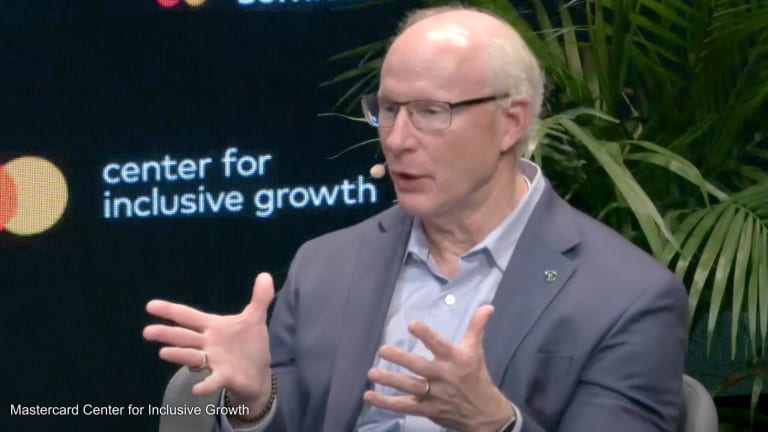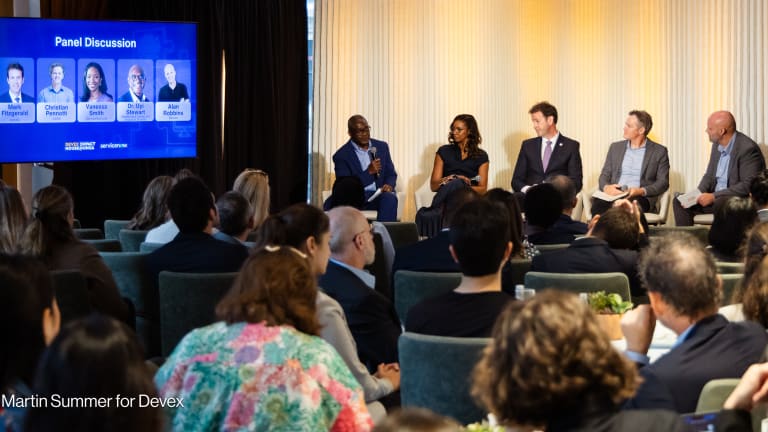
The pandemic has laid bare the longstanding barriers to affordable financial services faced by people all around the world, said Shamina Singh, founder and president at Mastercard Center for Inclusive Growth. But it also created “silver linings of progress,” she added.
“In the closing months of 2020, it became almost cliche to say that COVID-19 exposed the fractures across our societies, but from the standpoint of the financial services sector, really, nothing could have been truer,” Singh said.
Currently, 1 in 5 people in low-income countries don't have access to basic financial services, and nearly half of the global population lives in what Singh calls a “digital desert,” unable to access the Internet.
The pandemic has shone a spotlight on this disparity and spurred action, according to Singh. The center, similar to many other organizations, pivoted to address fundamental gaps in access to digital solutions and co-hosted the 2021 Global Inclusive Growth Summit to encourage “collective action towards rebuilding an economy that works for everyone, everywhere.”
Speaking to Devex, Singh broke down what the digital divide means for economic growth, how to make the economy work for all, and the efforts organizations are putting in place to make that a reality.
This conversation has been edited for length and clarity.
How does the digital divide impact individuals’ ability to participate in the broader digital economy?
People who lack consistent internet access have fewer touchpoints with the digital economy, which means they become more and more isolated in their work. For people who find themselves on the wrong side of the digital divide, they typically lack access to the training and support they need and as a result, their ability to weather future economic shocks will be challenging. We are at a high stake’s inflection point — and we need to ensure innovative solutions turn the digital divide into a digital bridge.
What should an ‘economy that works for everyone, everywhere’ look like?
In order to rebuild an economy that works for everyone, we will need innovative partnerships amongst public, private, and civic organizations, digital solutions, and bold new commitments.
At the [Mastercard] Center [for Inclusive Growth], we recognize that no one organization can do it alone. I have a rule of thumb which says, if you want to go wide, go with [the] government. If you want to go deep, go with NGOs and academic institutions. If you want to go fast, go with the private sector. If you want to go far, we all have to go together.
How has the pandemic impacted the center’s strategy around corporate philanthropy?
We really made a pivot in the very early days of COVID-19. The power of partnerships was evident to us in the early days of the pandemic — we made a commitment of $25 million to help establish the COVID-19 Therapeutics Accelerator with the [Bill & Melinda] Gates Foundation and Wellcome Trust. I am proud to say the Therapeutics Accelerator has since brought together more $339 million in contributions from 17 donors. Our initial funding provided diagnostic instruments and antigen testing for 48 African Union member states.
Then, in terms of the center and our work around social impact, we doubled down on creating pathways and connections to the digital economy. More importantly, we focused … on financial security, the resilience of small businesses, and for nonprofits and governments to not only work with small businesses, but also build their own capacity to realize the power of a digital economy.
“In order to rebuild an economy that works for everyone, we will need innovative partnerships amongst public, private, and civic organizations, digital solutions, and bold new commitments.”
— Shamina Singh, founder and president, Mastercard Center for Inclusive GrowthThe other thing, I think that we really pivoted to and lifted up — and we're going to see the dividends over the long-term — is our work to build the capacity of nonprofits and governments to use data science to tackle complex social challenges like homelessness, climate change, and global health.
It’s important to recognize that in order to rebuild an inclusive and sustainable economy, we must recognize that the divide between the data haves and the data have nots is increasingly becoming an issue that we must take urgent action to address. We worked with several organizations to build out data analytics capacity across the sector. Data.org is one of those partners. We have a partnership going with the Ford Foundation as well, and many others.
The summit the center co-hosted aimed to encourage ‘collective action towards rebuilding an economy that works for everyone, everywhere.’ What were the outcomes of that?
The summit, like our global impact, is a place where we have an opportunity to talk but also act. As an example, our programs have enabled 4.7 million people and 3.6 million small businesses in 48 countries to access financial services tools, know-how, and all the things that they need to survive and thrive in a digital economy. The summit put a spotlight on solution-oriented conversations with partners committed to taking collective action towards rebuilding a more equitable economy. We elevated the work of companies, government leaders, [and] nonprofit leaders — who operate globally but also at the grassroots level — to talk about what they’re doing and lift models of inclusion for others to replicate.
Organizations like JPMorgan Chase, Acumen, and Microsoft all used the summit as an opportunity to share commitments. In fact, during that day, we announced 10 new programs and more than $54 million in investments to ensure that the Global Inclusive Growth Summit not only brought together everyone — from Vice President Kamala Harris to former U.S. President Clinton to the head of the World Trade Organization to heads of foundations — [but also] commitments to action.
What would your call to action be for others to help in rebuilding an economy that works for everyone?
We’re working with many companies and organizations around the world to really advance a model where we can help aggregate corporate assets, nonprofit assets — or whatever it is that organizations have — to bring to the table. [We want to] help them realize their environmental, social, and corporate governance goals in a way that’s authentic, unique, and relevant to each individual organization. If each individual organization realizes the power of their own assets to realize their potential around ESG, then collectively, I think that's the place where we’ll start to see action that's going to impact at scale.








